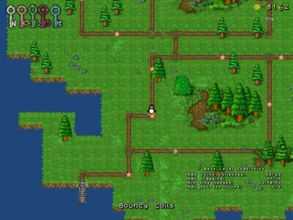This article has multiple issues. Please help improve it or discuss these issues on the talk page. (Learn how and when to remove these messages)
|

An overworld or a hub world is, in a broad sense, an area within a video game that interconnects all its levels or locations. They are mostly common in role-playing games, though this does not exclude other video game genres, such as some platformers and strategy games.
Description
An overworld or hub world is an area within a video game which connects its other levels or locations. The term can also refer to a safer area which players frequently return to, like a town. They are common in adventure games, role-playing games (RPGs), platformers, and dungeon crawlers. Multiplayer games have hub worlds which serve as a centre for interaction with other players and non-player characters (NPCs).
Hub worlds in single-player games are often used for worldbuilding, while hubs in multiplayer games are more purposed for storage for weapons and equipment, as well as restocking supplies. They serve as safe areas in between dangerous areas and quests where players can take on more passive actions. Wired and Kotaku described overworlds as a sort of "home" for the player in-game. They have also been considered an essential element of RPGs.
History
The 1981 arcade games Route-16 and 005 were among the earliest examples of a hub world. In Route-16, a driving maze game, exiting a maze takes the player to a large overworld map showing the locations of the player, cars, mazes and treasures. In 005, an early stealth game, players could enter buildings like ice rinks and warehouses from the main screen to avoid enemies, leading to different screens. The final scene tasks the players with controlling their getaway helicopter to escape and finish the level. Dubbed "a game in four screens", 005 was then described as a "RasterScan Convert-a-Game" according to The Encyclopedia of Arcade Games.
In Super Mario 64 (1996), Princess Peach's Castle serves as its hub world. Free of enemies, the castle serves as a safe area where players can experiment with its movement system and serves as an entrance to all other levels. Players are free to leave the castle whenever they wish.
Audio design
In terms of video game music, overworld themes are often orchestral in nature, and of greater length and complexity than other pieces in the same game, due to the amount of time spent travelling the overworld map. Because players will usually visit a single level or area a few times in a given play session, the music for any such section of the game will typically be shorter and/or less complex, and thus less time-consuming for the designers to produce. The overworld theme frequently functions as the main theme of a game, often used as a motif for other tracks (e.g., a "romance" theme features the main melody of the overworld theme, orchestrated in a different key).
See also
References
- ^ Everman, Tess (August 24, 2021). "How Hub Worlds Shape Video Game Design". Wired. ISSN 1078-3148. Archived from the original on 2021-08-24. Retrieved May 27, 2023.
- ^ Alexandra, Heather (January 29, 2018). "Hub Worlds Can Be Games' Greatest Pleasure". Kotaku. Retrieved May 27, 2023.
- ^ McFadden, Jason (April 8, 2022). "Ode to the Overworld". RPGamer. Retrieved May 27, 2023.
- ^ "Five great (but forgotten) alternatives to Pac-Man from the early '80s". Digitally Downloaded. 8 June 2017. Retrieved 7 December 2023.
- Biondich, Paul (2010). "005". AllGame. Archived from the original on November 14, 2014.
- Williamson, Riley (November 6, 2022). "Why Super Mario 64's Peach's Castle Is Such a Great Hub World". CBR. Retrieved May 27, 2023.
- Albiges, Luke; Thorpe, Nick; et al. (June 24, 2021). "Super Mario 64 turns 25: Examining the impact of the N64's most revolutionary game". GamesRadar+. Retrieved May 27, 2023.
- "The Evolution of Video Game Music". All Things Considered (Podcast). NPR. April 13, 2008. Retrieved May 27, 2023.
- Price, Seth (2002). "Early Video Game Soundtracks" (PDF). In Magazine. Retrieved May 28, 2023 – via UbuWeb.
Further reading
- Marshalkowski, Benjamin (April 19, 2016). "Overworld Overload: An Analysis of Link to the Past's Light World, Part 1". Game Developer. Retrieved May 27, 2023.
- Marshalkowski, Benjamin (April 25, 2016). "Overworld Overload: An Analysis of Link to the Past's Light World, Part 2". Game Developer. Retrieved May 27, 2023.
- Marshalkowski, Benjamin (May 13, 2016). "Overworld Overload: An Analysis of Link to the Past's Light World, Part 3". Game Developer. Retrieved May 27, 2023.
| Video game concepts | |
|---|---|
| Glossary of video game terms | |
| Attributes | |
| Characters | |
| Mechanics |
|
| Scenery | |
| Movement techniques | |
| Forms of play | |
| Game modes | |